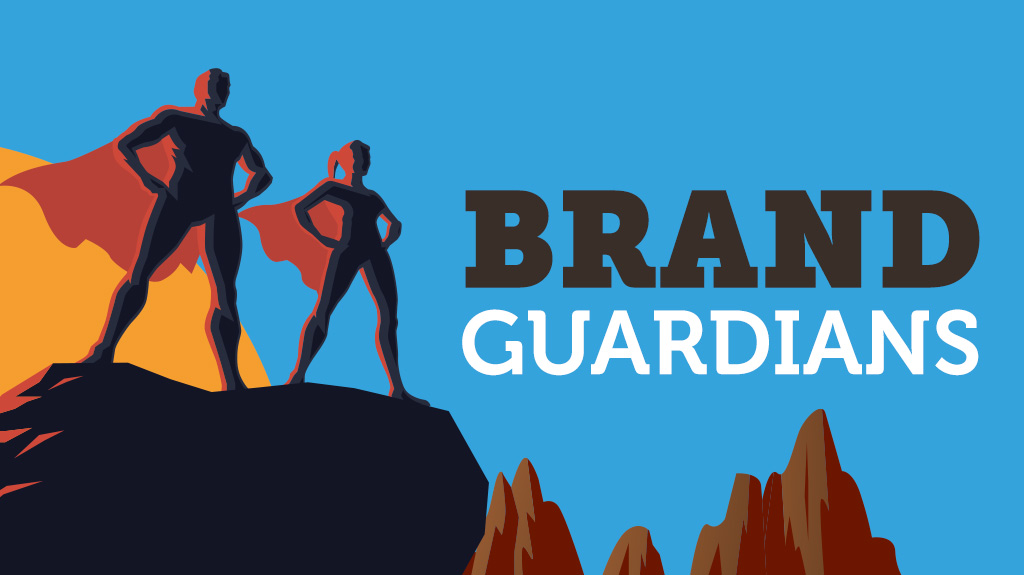Brand Guardians
We think getting your brand right is pretty important. But imagine that you’ve gone to all that trouble to get it right, and your new brand isn’t being applied properly by your staff.
You’ve put the hard work in, taken the time to reflect, understand and define your brand.
You’ve produced comprehensive brand guidelines, setting a clear tone of voice, a full colour palette, logo usage guide and understandable do’s and don’t’s.
You’ve brought your internal stakeholders, your staff, on the brand journey, demonstrated how it’s them that will bring the brand to life, run workshops and effectively communicated the launch of your shiny new brand.
Then why (OH WHY!) is Steve from accounts still using the old email signature!? How can Karen in Sales not know that the font and colour she used in the Word document she sent to that prospect is completely wrong?! And what on earth does the CEO think she’s doing using the old strapline in her latest internal update?!
It may feel unbelievably frustrating, but what you’ve experienced isn’t that uncommon. Some people need a little more support and to see the brand “in action” to start getting to grips with it. Others may struggle with old habits dying hard or may not be used to working in companies with such active brand awareness… so how do you solve it?
What you need is someone to take true ownership of the brand. What you need, is a brand guardian.
Choose your guardian
While it may sound like you’re getting a brand-related superhero, the job itself can be a little less glamorous. And as with any job, to make it a real success, you need someone with a particular set of skills.
You need someone with tenacity, who can act without fear of being lambasted by colleagues as a know-it-all or goody-two-shoes. You need someone who really gets the brand inside and out and can reign in those drifting from brand guidelines wherever necessary (and at every level, including the CEO!).
Your brand guardians need the impunity to take action, coupled with respect of the role from across all areas of the business. It may well be that the guardian has to ruffle some pretty senior feathers to enforce the brand, so it’s vital they’re taken seriously. A people person (not a people pleaser!) is useful in order to firmly guide people in the right direction.
Guardian’s, assemble
Entrusting “policing” of the brand to one individual is potentially a big ask, especially in complex organisations that may have multiple offices or locations. Instead, you might choose to have a number of brand guardians spread strategically throughout the business. The key here is ensuring consistency and sharing best practice.
In fact, your aim should be to slowly but surely turn each and every member of staff into a brand advocate and therefore a brand guardian in their own right.
What should brand guardians actually do?
So once you’ve got your brand guardians in place, what should they actually focus on? Ensuring the brand is correctly applied throughout every touchpoint is a daunting prospect, so it’s good to keep a few key areas in mind.
- Non-marketing documents – anything produced outside of the marketing team has the potential to be off-brand. A set of Microsoft Office templates is a useful part of the brand toolkit, but even if these have been created, they can easily be ignored or misused. Your brand can be totally eroded if fonts, colours and visual identity aren’t kept front of mind when creating documents for external consumption. Even with documents for internal use, make sure you don’t veer from the brand guidelines, as that’ll only undermine the brand amongst your peers. Your brand guardians should be checking that any document is correctly branded.
- Tone of voice – across both written and verbal communications, every interaction is a touchpoint and you need to ensure that your people are talking about the brand in the right way. Whether it’s how emails are started (“Hi Jim” is very different to “Dear Mr Baker” for example), the way people answer the phone (see above!) or anything else, the tone of voice that your people use should be consistent. Training, examples and prompts can be a good way to remind your people to consider the way they communicate. Your brand guardians should be checking for tone consistency and providing advice to colleagues where needed.
- Email signatures – ok, so we’re not going to lie, managing email signatures isn’t fun. With a range of email clients that all render visuals differently, even amongst different iterations of the same software (we’re looking at you, Microsoft Office), getting email signatures to look as you want them to reliably every time is tricky. It’s not impossible, but it can take some time even for those with experience in producing signatures that work across-client. So, you have to make sure that after putting in all that effort to get them right, people are adhering to your templates.
It might look fine to your colleague, but they almost certainly won’t be taking into account the intricacies of how different code is interpreted by different software. With email signatures, the rule should be to simply not deviate from the approved layout unless someone with experience in signatures is able to help. Brand guardians should keep an eye out for “tweaks” or changes to email signatures and explain to those changing them why it’s important to stay consistent. - Office “visuals” – while your main office signage will likely (hopefully!) be professionally produced, either by your own marketing team or a third party, it’s all too easy for people to get carried away with Word Art and start creating natty signs to put up around the place to remind people to load the dishwasher, empty the rubbish, print when only absolutely necessary and so on.
While these signs are often produced with the best intention, they are very, very rarely produced with anything other than a total disregard for brand guidelines. Remember, anyone who sees that sign in your workplace will relate it to your brand. Whether that’s a potential or existing customer or indeed your own workforce, this chips away at their perception of the brand and the hard work you’ve done on creating the brand. Nip these in the bud and either get them looking the way they should or, better yet, do away with them entirely.
Tell ’em, tell ’em and tell ’em again
These are just a few examples of the type of things that brand guardians will need to look out for. As we mentioned, the goal really is to instil the importance of maintaining the brand into all your members of staff and demonstrate why it’s so important for everyone to maintain a consistent approach. Training and workshops are another great way to bring your employees along on the brand journey, and while these may happen during or just after a rebrand, they may be worth occasionally revisiting to help keep the message alive. It’s only by repeating and revisiting how important this is that you’ll get buy in from everyone.
And remember, as you have new colleagues starting, they’ll need to be brought up to speed on the brand too. Ensuring any new hires understand the importance of the brand should form part of their induction and be considered very much part of the job.
Square1 has lots of experience in supporting businesses and their employees through rebranding and beyond. We can facilitate training and workshops that help instil your brand across the workforce for a more consistent experience.
Get in touch today for a chat about your brand and how we might be able to support your objectives.




